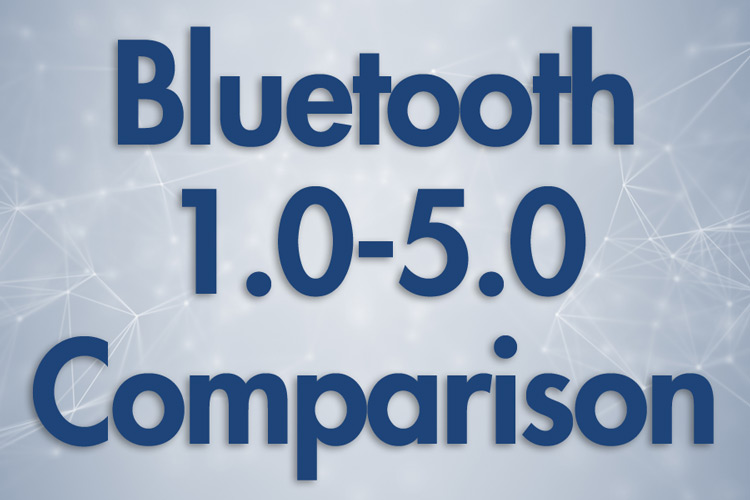- Home
- Symmetry Blog
- How Bluetooth 5.0 is Changing the Medical Industry | Symmetry Blog
How Bluetooth 5.0 is Changing the Medical Industry | Symmetry Blog
About Augustine Nguyen
Augustine Nguyen, Applications Engineer at Symmetry Electronics, breaks down how Bluetooth 5 is changing the medical industry. Read about the exciting innovations that the newest version of Bluetooth can provide to healthcare IoT.

When advancements in healthcare technology reach the front page of news, the topics usually border along science fiction. Our imaginations run wild when we think about experimental projects that provide biological enhancements, cure life-threatening diseases and alter our DNA. It is the long-term goal for many in the industry that we make these big strides in improving our quality of life.
In practice, however, the most significant improvements in healthcare are the ones that tackle the efficiency and effectiveness of the healthcare system. Budget cuts and a growing population continue to constrain healthcare costs. Being able to provide healthcare coverage to everyone is a challenge that hospitals, researchers, non-profit organizations and the government are looking to solve.
It is the integration of new technology that helps tackle this challenge.
Smart devices and applications in healthcare make it easier:
- for patients to stay on top of habits
- for doctors to track changes in health
- for administrators to safely manage inventory
- for drugs to be administered correctly
These are all examples of how the Internet of Things is changing the way healthcare helps individuals improve their prognosis. Bluetooth Low Energy is at the forefront of healthcare technology, and the latest improvements in Bluetooth 5 open up what is possible for future healthcare administration.
Keep reading to find out how BLE & Bluetooth 5 is changing the medical industry.
Bluetooth 5 Improves the Versatility of BLE
In a previous post, “Bluetooth 1.0 vs 2.0 vs 3.0 vs 4.0 vs 5.0 - How They Differ,” we learned that Bluetooth 5 improves the versatility of the Bluetooth Low Energy (BLE) protocol introduced in version 4.0:
“Unlike version 4.0, Bluetooth 5 offers four different data rates to accommodate a variety of transmission ranges: 2Mbps, 1Mbps, 500kbps, 125kbps. Because an increase in transmission range requires a reduction in data rate, the lower data rate of 125kbps was added to support applications that benefit more from improved range. For example, tiny sensors are not required to send large amounts of data, so reducing the data rate allows these sensors to transfer information as far as 240 meters. In contrast, the option to transmit data at 2Mbps is geared towards applications where the range is expected to be short but can greatly benefit from the increase in data speed. The flexibility in data speeds offered by Bluetooth 5 allows low powered products to send even more sophisticated data to the end user.
If you need a refresher on how Bluetooth Low Energy (BLE) differs from older versions of Bluetooth, read the full article here.
Why Use Bluetooth Low Energy (BLE) in Healthcare?
In a medical publication in the Journal of Diabetes Science and Technology, Alf Helge Omre presents Bluetooth Low Energy as an ideal wireless communication technology for medical use and is the first wireless communication technology that meets these requirements:
- Interoperability—ensuring that products from different manufacturers can communicate with each other;
- Low-power operation—so medical monitors can run for months or even years on tiny coin-cell batteries, reducing maintenance and running costs;
- Customized software optimized for medical applications and transmitting data in a format requested by medical authorities;
- Compatibility—radio devices need to coexist with other radio transceivers and cause no electromagnetic interference (EMI) in other sensitive electronics devices;
- Transmission of data must be secure to protect confidentiality; and
- Sensors need to communicate with services such as the Internet and the cellular network so that information can be relayed to remote health practitioners.
It is important to understand the factors that affect the implementation of wireless technologies in medical applications. Not only are medical applications limited by wireless range, data rates, frequency interference and general technology constraints, but real-world implementation is dependent on costs. Health care reform is constantly looking to cut costs without compromising patient care, and while new technologies can provide immense healthcare benefits, the important factor to real change is how realistic these technologies are against the shrinking budgets that healthcare institutions face.
It is for this reason that BLE is a very attractive solution for advancing wide-spread health around the world. Using body-worn wireless electronic monitors save the healthcare industry billions each year (Hatler M, Gurganious D, Chi C. Wireless sensor networks for healthcare. ON World Inc. 2008. Aug,) by providing frequent contact with healthcare providers and mitigating lengthy hospital visits. Likewise, wireless monitoring at a patient’s home would replace routine measurements conducted by visiting nurse staff, saving billions a year. This would be important in counteracting the expected increase in health care spending as more people grow older and suffer from chronic diseases.
How is Bluetooth 5.0 changing the medical industry? Let’s look at a few examples.

Connected Inventory
Detecting the condition of medical inventory is also an important application for improving healthcare efficiency. Inventory - like medication, equipment and patient samples - can be wirelessly evaluated for defects or expiration.
One such example would be a blood bank. Blood must be stored within a specific temperature range or it would not be deemed safe to use. By attaching a Bluetooth Low Energy sensor tag to each blood bag, the temperature of the stored blood can be tracked and recorded at specific intervals, sending this data to a Bluetooth gateway to be stored. This helps healthcare professionals know whether the blood would be safe to use for those who need it.
Installing Bluetooth asset tags onto the boxes of pharmaceuticals also benefit the management of inventory. These tags interact with Bluetooth beacons installed throughout the building. The beacons help monitor environmental factors such as temperature and humidity, sending data to a server about how long specific medicines have been stored in specific conditions. With improvements in Bluetooth 5 and its increased range and data throughput, assets can now be tracked over a larger area while still having a robust connection.
Diabetes Injection Pens
For medical professionals treating those with diabetes, proper use of a diabetes injection pen is vital. Helping patients build the right habits when administering the pen is a challenge for physicians, and the use of Bluetooth Low Energy technology helps improve the success of diabetes management.
When using a Bluetooth-enabled diabetes injection pen, patients would use an app to help calculate the correct dosage to inject. The app would gather data based off of what meals the patient has eaten, blood glucose meter readings, time of day, and the amount of exercise that was done before injection. A recommended dose would be given, and the patient would accept and administer the dose directly on the pen. This would make home administration of diabetes pens much more effective, especially in underserved communities.
Blood Glucose Monitoring
When a patient is hooked up to an intravenous drip, a Bluetooth-enabled blood glucose monitor can be used to wirelessly alter the flow rate of the IV drip, adjusting to a patient’s insulin levels. Using this mechanism helps save time out of the medical staff while also allowing for automated distress signals to physicians when a situation occurs that requires professional attention. Because Bluetooth 5 allows for different transmission rates, signals sent to the IV drip can use the higher data rate, while distress signals can be transmitted at the lower data rate with the longer range, reaching a physician or central computing hub that could be farther away from the patient.
Automated drug inhalers
Drug inhalers treat patients with medication that are best administered through the lungs. For those who suffer from asthma, inhalers are heavily relied upon, so tracking data associated with their usage can be an important tool for users looking to improve their own experience. A smart-enabled automated drug inhaler would be able to send dosage history from the inhaler to a smartphone app, letting users chart out the usage of the inhaler across the number of uses, time of day, frequency and remaining doses. If various user errors occur, the app can even provide users with online videos to help improve inhaler use.
Bluetooth-enabled medical Monitor devices
Outside of the hospital, Bluetooth-enabled medical devices can track patient progress in the form of data sent to the smartphone. The data can then be presented to a medical professional on the next visit or the data can be sent wirelessly to the hospital. Such a device can also be life-saving. In the event of an emergency, the device can work with the smartphone to make an emergency call, providing first responders with the patients’ locations using the smartphone’s GPS.
Connecting these devices together under the same roof is the key to utilizing Bluetooth’s greatest strength. With the interoperability of Bluetooth, the different devices – weight scales, heart rate monitors, blood pressure monitors – can track a patient’s health at home and link the data together to a local hub, like a smart hub. From the smart hub, the data can be gathered and processed to be sent over long distances to a medical professional or a caregiver. This makes connected home health a lot more manageable for health professionals, who can have all the data in one central location, rather than receiving multiple different data sets and having to manage the data between them.
Conclusion
It’s exciting what innovations will come out of IoT in healthcare. We have the ability to change not just the way healthcare is provided, but the behavior associated with proper health administration. Personalized healthcare is more important than ever as we look to offset the constraints of tightening healthcare costs and available personnel. Bluetooth 5 is poised to set a new standard on pushing the future of our health.
Read Other Related Posts by Symmetry Electronics:
 What does Medical Grade Mean for Power Supplies
What does Medical Grade Mean for Power Supplies


